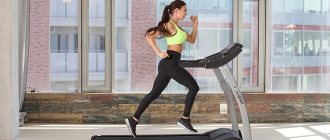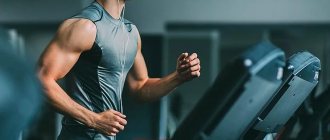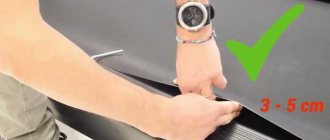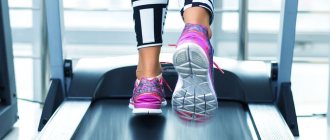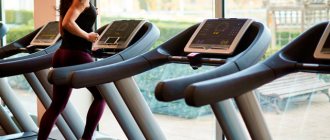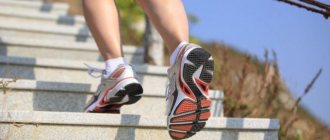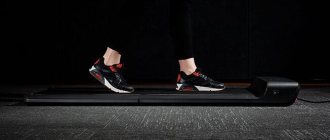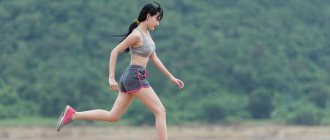≡ October 1, 2015 Category: Miscellaneous
Any walk, even just five minutes, is still much better than lying on the couch or sitting at home all the time. But if you want to get the most out of walking, lose weight and improve your health, then follow these simple rules that are easy to remember:
- Walk strictly every day. You can start with a half-hour walk three times a week, adding one day each week.
- Walking doesn't have to take you half a day, but it should last at least 40 minutes a day. Doctors have found that this is the optimal time during which the body manages to saturate the blood with oxygen, lower cholesterol and burn extra calories. It is advisable to divide these 40 minutes into three stages: five minutes of walking at a slow pace to warm up the body, 30 minutes of fast walking and five minutes of walking at a slow pace to cool down. In fact, almost all types of training are built on this principle.
- Scientists have also found that 40 minutes of continuous walking burns as many calories as 4 ten-minute walks. Therefore, take advantage of every free moment to fulfill your daily quota if circumstances do not allow you to take long walks.
- A lot also depends on the number of steps you take. To maintain weight at the required level, you need to walk about 10 thousand steps. The number of steps you take can be calculated by a device such as a pedometer.
- The basis of proper walking for weight loss is posture. Keep your back straight at all times by drawing an imaginary straight line from your ear to your shoulder, hip, knee and ankle. Fix this position and try to stick to it. Keep your head straight and do not tilt it when walking forward, as this puts excess tension on the muscles of the neck and shoulders. Keep your chin parallel to the ground and, if you need to look at your feet, lower your eyes, not your entire head.
- Weights, which are sold in most sports stores, will allow you to turn any walk into a fat-burning workout. The safest is considered to be a belt that increases the load evenly on the muscles of the abdomen, buttocks, legs and lower back. A belt for beginner walkers can be used with a weight of no more than 1-2 kg. Use regular dumbbells; you can also do additional exercises for your arms while walking. Weights on the ankles are good for the hips - especially the front and back surfaces, as well as the buttocks. Weighted ankle bracelets are hung directly on the ankles, above the sneakers. You can start with 0.5 kg.
- Do not hold your arms straight while walking - this can lead to swelling, tingling and numbness in your fingers. It is more natural for the body to keep the arms in a bent position and slightly pressed to the body.
- Bend your arms at a 90-degree angle and move them vigorously to increase your calorie burn by 15 percent and strengthen your biceps, triceps, and deltoids.
- Learn to place your feet correctly while walking. In order not to overload the spine and joints, you need to learn to walk in such a way that the body weight is smoothly transferred from heel to toe, and it is important to try to lean more on the outer side of the foot.
- Walking for weight loss on rough terrain with elevation changes, or on sand, will allow you to burn another 30% more calories. If you live by the sea or by a river where there is a sandy shore, here is the best place for your walking.
- Finally, breathe correctly, and the correct breathing when walking is inhaling for the first two steps and exhaling for the next two.
And finally, information for those who plan to lose weight by walking.
The World Health Organization has recognized walking as the most effective and safe way to lose weight. Unlike running, which primarily burns carbohydrates and protein, walking burns fat.
Therefore, put aside doubts and move forward - a quick step towards health and harmony! Agidelia especially for the “Fitness” section
Who can do it and where to start
Walking, as the simplest and most accessible form of physical activity, can be practiced by people of absolutely any age. Begin to gradually introduce short walks, gradually increasing the duration to 1 hour a day.
But, like any type of physical activity, walking has a number of contraindications:
- High blood pressure;
- colds and other acute diseases (especially if they are also accompanied by an increase in body temperature, chills and poor health);
- diabetes mellitus and chronic kidney disease;
- cardiovascular disorders, stroke and heart attack in the recent past.
Human walking speed
Squeeze your shoulder blades, tighten your stomach, raise your head and go out into the park or onto the street. Increase your walking time and speed gradually. In sports medicine, there is such a classification of walking.
- Very slow Up to 3 km/h Up to 70 steps
- Slow 3-4 km/h 70-90 steps
- Average 4-5.5 km/h 90-120 steps
- Fast 5.5-6.5 km/h 120-140 steps
- Very fast Over 6.5 km/h Over 140 steps
Men from 40 to 55 years old can gradually reach a speed of up to 10 km/h, after 55 years old - up to 7 km/h. Women under 40 years old can move at a speed of 10 km/h, from 40 to 55 years old - 7 km/h, over 55 years old - 6 km/h.
Walking can be done in any weather two hours before or two hours after meals. Start walking four times a week for 45 minutes. Gradually, the cardiovascular system will adapt to the stress, and you will notice positive changes. In a trained person, the organs at rest work more economically, and when necessary they are very resilient. To enhance the healing effect, you can walk with dumbbells, in which case the muscles of the upper body will work more actively. At first, do no more than half of your workouts with dumbbells; their weight should be no more than 600 grams. If you feel normal, then after two months you can wear dumbbells for the entire session.
For weight loss
Some may say that walking on stairs to lose weight on your legs is too easy and that running is better. Well, you still try to walk for 40 minutes at an average pace. Believe me, you will load your muscles so much, and at the same time train your endurance, that your eyes will bunch up!
Running up the steps in the entrance has a right to exist if you are already a trained person! Otherwise: just walking!
In addition, you should absolutely not run/jump with excess weight. Therefore, if your excess weight is more than 10 kg, aerobics, Zumba, work-outs and other abuse of your joints are strictly prohibited. Even doing isometric exercises like planks or chairs is highly undesirable!
Don’t fall for the tricks of fitness trainers who try to sell you their video programs at a higher price: have you ever seen overweight people doing similar exercises? Have you ever wondered why all the videos showing this or that exercise show slender girls? Why not full?
There are many great exercises you can even do at home. We have already written about this and will repeat it again: for truly obese people, losing weight should begin with a diet, and continue with walks and exclusively strength training!
How many calories are burned?
Of course, we can only talk about averaged data. The calorie expenditure of lifting depends on your weight, speed of movement, knee height, stride width and metabolism.
On average, in 15 minutes you spend about 100 kcal. A woman weighing 70 kg will burn about 500 kcal in 1 hour of training on the stairs, climbing at an average speed.
Harm and contraindications
It is important to monitor your breathing. Improper breathing while walking can cause more harm than good. When walking quickly, there is a risk of harming your knee joints, so watch the condition of your knees. If they start to hurt you, it is better to postpone classes for a while and consult a specialist.
There are very few contraindications to this sport. Let's list them:
- Viral infections
- Recent surgeries
- Chronic diseases in acute form
- High blood pressure
- Flat feet
- Hand and joint injuries
- Deviations in the development of the musculoskeletal system
- Heart disease
In all these cases, you need to consult a doctor about the possibility of walking at a leisurely pace for short distances. If you have flat feet, the load during walking is distributed incorrectly, and you can harm your condition even more.
Tips for running workouts with dumbbells
Before you start running, check your Body Mass Index (BMI) to see if the impact of using additional weights will be too much for you.
BMI is a value that gives an idea of the correspondence between a person’s weight and his height. The convenience of this index is that it allocates a certain range for the optimal weight, without indicating a specific weight as in the case of other calculations.
To determine your BMI, divide your weight by your height (in meters) squared, and divide your weight by that value.
For example:
- height 162 cm, weight 60 kg;
- height square: 1.62*1.62= 2.6;
- divide the weight by the resulting value: 60/2.6 = 23;
Thus, the body mass index is 23.
If the Index value is: 19-25 (normal), 26-30 (overweight), from 31 (obese).
If you are overweight, it is better to limit yourself to regular running without additional weights, so as not to harm your knee joints.
Before running with dumbbells, do a full warm-up, warm up your joints, ligaments, and muscles. Perform several rotations in the shoulder girdle, hip joint, knee and ankle joints. Do a few squats, lunges, and short bursts. When you finish your run, do some stretching.
When running with dumbbells, try to avoid asphalt surfaces. This is the most unfriendly coating for our feet. The asphalt surface is hard and does not create a shock-absorbing effect, and additional weight only intensifies the impacts that are perceived by the knee joints and the entire musculoskeletal system.
The advantage of a dirt surface is not only that it is softer than asphalt and thereby softens the shock load, but also that, due to its softness, it additionally loads your muscles.
Rubber coating is the best option for a running surface. If your stadium has a rubber running track surface, and you have the opportunity to go on such a track, then your running conditions are close to ideal!
Follow the correct running technique: start at a slow pace, run from toe to heel, do not fully extend your knees, raise them when running, place your feet in the direction of movement. Watch the position of your torso while running and do not twist it.
Please also pay attention to the following features of running with dumbbells:
- if you are new to running, go for a run without dumbbells, the additional load at the initial stage of training will only harm you and negatively affect your joints and running technique;
- start by walking with dumbbells for 10 - 20 minutes to understand how ready you are for such a load;
- start running with dumbbells weighing 0.5 - 1 kg, gradually increasing their weight;
- use special fitness dumbbells that do not slip out of your hands during running swings and absorb moisture from your palms;
- you can also use overlay cuffs with removable metal plates, which are secured to the limbs using fasteners or Velcro;
- if it’s hard to run the entire distance, alternate it with running without dumbbells;
- while running, hold the dumbbells at chest level, using your arms as you would during normal running, rather than just holding the dumbbells in your hands;
- breathe deeply through your nose, exhale strongly every three steps, thereby you will be able to concentrate more on running;
- avoid running over rough terrain, which can cause unpleasant injuries;
- use running shoes with good cushioning: thick soles, well-cushioned heel and foot;
Running with dumbbells is a fairly serious physical load on the body, the positive effect of which you can get by observing moderation in increasing the intensity of the load, warming up well before running and listening to your physical condition.
How to lose weight by walking
If you have seriously decided to lose weight through walking, then you will have to do it every day! Otherwise, if you do this only from time to time, you will not see results.
At first, if your body is not yet trained, it will be enough to spend 30 minutes walking. However, the time should be gradually increased (at least up to 1 hour).
Younger and healthier people should focus on speed and pace; older people (or those who have any illnesses) should prefer long walking, but at a moderate pace.
If possible, it is better to go in the morning. Firstly, fat deposits are burned more easily in the morning. And secondly, such a walk will give you energy and positive impressions for the whole day. Although it is believed that walking before bed is very beneficial.
Remember that any physical activity should begin with a warm-up. And walking is no exception. Therefore, first walk a little at a slow pace: let your muscles warm up.
To avoid dehydration, always take a bottle of water.
Finish walking, reducing the pace gradually: let your body recover.
Correct technique
Let's discuss the correct technique for such running training:
- Use light dumbbells/weights (0.5 - 1 kg);
- It is better to buy specialized fitness dumbbells. They fit securely in the hand, absorb moisture, and do not slip out;
- It’s even more convenient to use weights - the cuffs are secured with clasps;
- Place your hands at chest level. Under load they can fall down;
- Remember - hand movements are extremely important! Do not keep them statically near the body;
- Excessive swinging is also harmful to the body;
- Try to maintain your usual jogging technique, gradually increasing the pace.
How to increase your calorie expenditure
If you have been walking for a long time, have learned to breathe correctly, and control your pulse, then you can use the following options to increase the intensity of your training:
Active movements with your arms and legs will help you add a little variety.
After warming up (after 10 minutes of walking at an average pace), add raising bent legs at the knees for each step, or leg sweeps (heels touching the buttocks), or body turns for each step, or swinging your arms to the sides (do 20-30 repetitions and alternate with normal walking). Such active movements will slightly increase calorie consumption during exercise.
Add extra weight - this could be arm and leg weights, small dumbbells, or water bottles.
Walking with weights will significantly increase calorie consumption and increase the effectiveness of your workout. And if you also add swings with arms or legs with weights, this will give double the result. The most important thing is to watch your pulse, watch your breathing and drink more water.
Walking with poles (Nordic walking) is a great way to diversify your activities.
This type of walking is gradually beginning to gain momentum in Russia and is mainly common among the more mature population. The essence of such walking is to add the main load to the body by pushing off the surface with sticks. The upper belt (arm muscles, latissimus dorsi, shoulders, abs) is actively involved in the work, which leads to greater training intensity and, accordingly, to burning more calories. The load is regulated by each person individually, based on physical fitness and assigned tasks.
Exercise with weighted cuffs on the shoulder muscles
In light of the above, it is only natural that it is very important for a runner to keep the arm muscles in good shape. There are a number of exercises for this.
Feet shoulder-width apart, back straight. The starting position of the expander is at chest level, arms parallel to the shoulders. The expander is stretched alternately:
- perpendicular to the body - return to the starting position
- parallel to the body - return to the starting position
- from the right shoulder to the left hip - return to the starting position
- from left shoulder to right hip - return to starting position
The set of movements is repeated several times.
With the help of fitness training with dumbbells, you can strengthen and tighten the core muscles of your arms. The targets are usually the deltoids of the shoulders, biceps, and triceps. The lack of tone in the triceps gives the effect of the so-called “bat wings”, when the skin of the shoulders sags, becomes flabby and unaesthetic.
Thanks to regular exercise, you can speed up the burning of fat deposits in this area and ensure an increased flow of oxygen to the muscle tissue of the arms. This will help improve the supply of nutrients to cells and make the skin firmer and more elastic.
When selecting sports equipment for training, it is recommended to opt for collapsible models. Begin the exercises with minimal weight, gradually increasing the load as the muscles adapt. Working with free weights is good because, in addition to the target muscles, you also work out many auxiliary ones that ensure balance and correct body position. Girls can use dumbbells of the smallest weight of 1-2 kg, since their main task is to tighten the muscles, and not to increase their volume.
Due to the small size and low weight of the equipment, physical activity with dumbbells is suitable for any age category. If you follow the correct technique, training will be quite safe even for older women who care about their appearance.
What you need for walking
Before walking and after, you need to drink a glass of water to replenish fluid loss. For a walk, you can take a bottle of warm, not hot water with you and drink during breaks. Clothing should be comfortable and not restrict movement. A tracksuit and sneakers are best for this. Shoes with heels should be excluded. You can take your player for a walk, combining business with pleasure. After class, when you come home, you can have a snack, but do not overeat. When you get into the groove and exercise becomes a habit for you, the pace can be increased. It is useful to combine walking with morning exercises.
Norm of steps per day
It is believed that to feel good, you need to take at least 10,000 steps a day - which is 6-8 km, depending on the length of the step. It is estimated that the average person takes about 3,000 steps a day, including walking at work and around the house. Therefore, in order to gain the required number of steps, you need to try hard and spend an additional hour walking a day.
True, many experts believe that only “pure” steps are taken into account here, i.e. walking around the house or running errands has nothing to do with it. If it's cold or raining outside, a treadmill can replace walking. You can not only run on it, but also walk at a leisurely pace.
It is important to control your breathing and your condition and not forget about the mileage.
You may feel dizzy
Many people don't like to run on treadmills because they feel dizzy after exercising. “If you use your hands on the machine to maintain balance, your internal balance system is not working,” says Changha Hwang, a physical therapist. “When you step off the canvas, the balance system will suddenly turn on again, and you will feel dizzy or floating in space.” To reduce discomfort, walk more slowly on the treadmill and, again, avoid holding the handrails with your hands.
